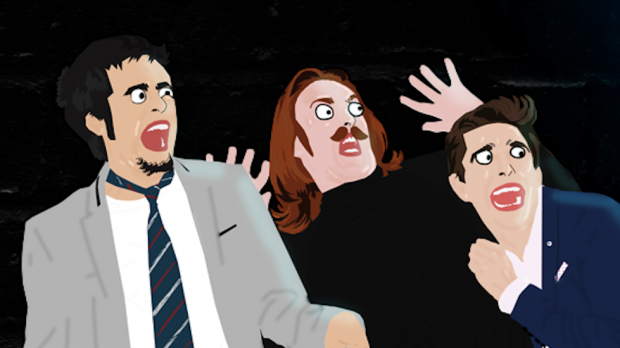
Late Night Bone Moe @ Lazy Susan’s Comedy Den
Friday, January 24, 2020
Late Night Bone Moe is a fun, phantasmagorical comedy by theatre troupe Bone Moe. Written and directed by Nic Doig, Evie MacPherson and Davis Anderson, the Perth-based ensemble takes a somewhat democratic approach to theatre-making. Framed as a televised talk show and boasting fourth wall breaches, diegetic and chronological experiments, and thematic absurdism, the show is as colourful as it is comedic.
One of the most striking features in Late Night Bone Moe is the strength of the characterisation. Without exception, every performer delivered with vibrancy, bravery, and enormous energy. Some of the characters are cartoonish stock characters. Others are caricatures of the performers, conflating names and identities in a metatheatrical reconciliation between art and life. With wild gesticulations, dramatic asides, and excessive physicality, the loud vitality of these characters shines against a minimalistic backdrop.
Bone Moe’s oeuvre is characterised by its absurd but good-humoured silliness, comic wit, larger-than-life characters, and metatheatrical technique. The collaborative chemistry of the ensemble is palpable. The dialogue sparkles with unexpected segues, melodramatic asides and punny humour. Bizarre, visually striking tableaus verge on the grotesque, yet the potential verfremdungseffekt on the audience is diffused by clever wordplay. In fact, much of the humour in Late Night Bone Moe emerges in these kinds of juxtapositions between the sordid and the silly: Callum (Callum Presbury) strums a guitar in a jolly major key while ‘Crazy’ Davis (Davis Andersen) laments; dire political issues are teased out with madcap irreverence. The show considers the weight of the world, and simply laughs it off.
With digressions, interruptions and stylized mistakes, the Late Night Bone Moe experience is metatheatrical and playful. The dialogue draws attention to the artifice of the medium – the subterfuge of the prop moustache; the impotence of the prop gun. Paradoxically planned disruptions – such as Maximilliano entering half-dressed in a shower cap and bathrobe – subvert audience expectations of a polished theatrical experience to humorous effect. Performers directly address the audience members. These fourth wall breaches do not serve a political agenda as much as they establish a friendly, conversational relationship between performance and audience. From the outset, the audience is positioned to interact with – even co-author – the performance by adding to a jar of randomly-selected improvisation suggestions. At times, the dynamic between audience and performance is raucous and outright cheeky: an explicitly phallic alien invader (Ken P’Ogwaro) passes through the audience and takes centre stage; Dracula (Maximiliano Laffont) refers to an individual audience member as a “virgin”; Nic enters stage left and rubs someone on the scalp. But it is always good-spirited and met with mirth.
Performative flashbacks and anecdotes create a fast-paced, non-linear chronology. This is toyed with even further when flashbacks are suddenly interrupted or disallowed (“You’ve had enough flashbacks!”). As the lights go down for the last time, the cast exits through the audience and out a back-door stage entrance while Davis, handcuffed to the set, remains onstage. His awkward, lingering presence continues to disturb the fourth wall and disrupt the ‘real’ well after the show has concluded, allowing the impossible chronology of Late Night Bone Moe to transcend representation and flow into the real, its timeline as inexorable as time itself. The performance’s experimental chronology contributes to its playful relationship between art and life.
One of the most novel achievements of Late Night Bone Moe is its integration of generic conventions from television into the medium of live theatre. In particular, it pays homage to talk shows and game shows – and, in doing so, frequently engenders a clever satirical commentary on late capitalism. Newscaster Tristan (Tristan Peers) momentarily breaks free from the performance due to technical difficulties. A TV technician (James Jury) is the catalyst for a deus ex machina. Callum periodically holds up signs, like those for a studio audience, prompting them to react with “boos” and “awwws”, surrendering theatrical spontaneity to the scripted stylisation of television. Nic refers to the constraints imposed by “the network”, a faceless, omniscient, corporate entity. The improvisational segment of the show is comprised of faux commercials for deliberately impractical goods, their uselessness highlighting the absurdity of a hyper-consumptive society. The observational wit of framing the performance as a product may remind the audience of the vulnerability of the arts to neoliberal co-optation.
The gravitas of the theatre tradition, too, is satirised – through gentle mockeries of Aristotle’s “catharsis-y thingy”, or unexpected and ridiculously grandiose asides in Early Modern language. In particular, Nic parodies the proverbial egotism of the actor, neurotically pleading with the audience to laugh. This culminates in the outstanding musical number Look At Me, performed by the entire ensemble. It must be said that the beauty of the vocals – particularly the exquisite harmonies sung by Evie (Evie MacPherson) and Melissa (Melissa Escobar) – momentarily distract from the self-indulgent silliness of the lyrics. But the rapturous sound is quickly and comically disrupted by Nic’s ear-splitting screech from stage left, creating yet another humorous juxtaposition between the weighty and the wacky.
Late Night Bone Moe is a brilliant and innovative vaudevillian revue-cum-talk show. It toys with genre and chronology to comic effect, revolutionising the theatrical experience with its experimental approach. Joyful, surreal, and escapist, the show sees audiences breathless with laughter.
AMBER GALBRAITH